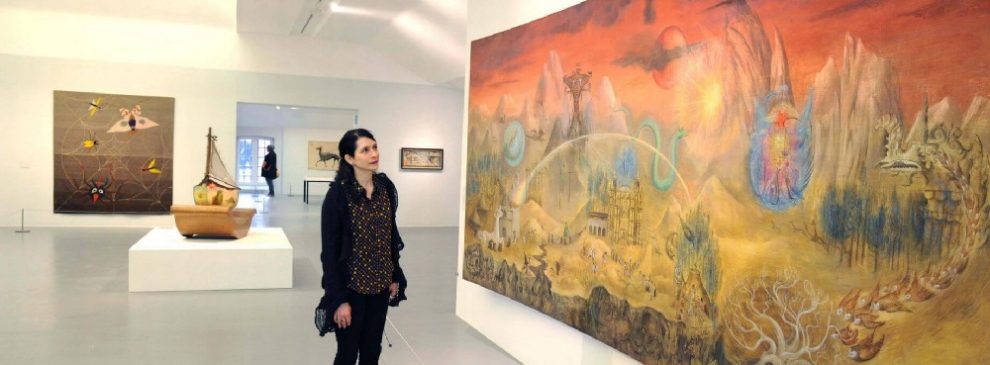50th Anniversary of L’Amour de l’Art: Have museum visitor profiles really changed?
Added on Wednesday, February 22nd, 2017
…
In 2016, social science celebrated the 50th anniversary of the first edition of L’Amour de l’Art: Les musées et leur public, by Pierre Bourdieu and Alain Darbel ([1966] 2007). This work is perhaps minor compared to Bourdieu’s other works in the field of culture, particularly Distinction: A Social Critique of the Judgement of Taste published 13 years later (1979). However, L’Amour de l’Art is still one of the most influential sociological works for museum studies. In November 2016, the Centre for Research and Studies in Sociology (University Institute of Lisbon) and the Art History Institute (Universidade Nova de Lisboa) in collaboration with the Portuguese Ministry of Culture organized a conference intended to reflect upon current developments in museum visitor studies, bearing in mind Bourdieu’s contribution to the field.
Before I joined the ICC in September 2016, I had been researching museum visitor profiles in Portugal for a few years with Alice Semedo e Celia Oliveira (University of Porto, PT). The ‘MoVEM: museums visitants’ experiences and motivations’ research team was invited to join the 50th Anniversary of L’Amour de l’Art: Debts, Criticism and Challenges conference and reflect on the project’s preliminary conclusions. Appointed by the Northern Regional Directorate of Culture, MoVEM allowed us to pilot a study of visitors to national monuments and museums in the North Region of Portugal.
The MoVEM project and L’Amour de l’Art
MoVEM’s main goal was to produce knowledge on the museological panorama of the north of the country, by identifying visitors’ profiles, perceptions, attitudes and practices. We were aware of the 50 year research legacy after L’Amour de l’Art in Museology and Sociology, but also it was important to acknowledge changes in contemporary life and its impacts on cultural consumption and production. Therefore, this study’s conceptual approach looked at the museum visit as a form of cultural production and communicative action and, as such, as an integrant part of patrimonialisation processes. Visiting a museum integrates the set of cultural practices that uses the past for the creation of present cultural experiences. Thus, visitors’ practices are seen as emotionally invested interpretations of the past, which at the same time, integrate not only the contemporary identity of the individual, but also the construction of a sense of place. The museum visit, in the scope of this study, is perceived as a subjective political negotiation of identity, place and memory.
From the point of view of museum visitor studies, L’Amour de l’Art is a key text in several ways: it was one of the first extensive studies carried out in Europe; it was the first scientific method approach to study museum visitors; it clearly argues taste as a social construction and mass schooling as a central instrument of legitimation. Undoubtedly, L’Amour de l’Art is a historical landmark in the articulation between sociological research and cultural public policies, and has been present in sociological studies on cultural participation for the last 50 years.
In fact, in the 50 years that separate us from the first edition of L’Amour de l’Art, the world has changed more dramatically and faster than ever before. The world is different; life contexts are different; why shouldn’t art museum visitor profiles be different?
Ever since cultural policy across Europe has promoted cultural democracy, mass schooling seems to, in a sense, fulfil its promises; cultural massification is in the palm of our hands; museums dedicate entire departments to accommodate visitors and design strategies to seduce non-visitors. However, museum visitors have repeatedly been shown to be highly educated and recognisable as members of the upper (the ‘bourgeoisie’ in Bourdieu terms) and middle social classes – exactly as Bourdieu and Darbel portray in L’Amour de l’Art 50 years ago.
Laurie Hanquinet, Senior Lecturer at the Department of Sociology at The University of York (UK) opened the conference with a presentation on her work on visitors of modern and contemporary art museums in Belgium, stressing mainly two points: yes, art museum visitors in Europe are still highly educated and recognisable as members of the upper and middle social classes. However, heterogeneity of visitors’ cultural practices needs to be taken seriously in order to broaden our understanding of who art museum visitors are.
Modelling the museum visitor experience
John Falk (2009) perceives museum visits as part of people’s lives. This author has been developing a model of visitor experience analysis that reconceptualises the field from a holistic perspective using the ‘lens’ of visitors’ identity and motivations. The model proposes to understand visitor experiences in the scope of their own identity, decision-making and meaning-making strategies, memory, and leisure preferences; in this sense, he tries to see visitors beyond their socio-demographic features. Five key types of visitors were identified: i) Explorers (motivated by personal curiosity); ii) Facilitators (motivated by other people and their needs); iii) Experience-Seekers (motivated by the desire to see and experience a place); iv) Professional/Hobbyists (motivated by specific knowledge-related goals); v) Rechargers (motivated by a desire for a contemplative or restorative experience). Despite the fact that one person can have different experience types at different moments at different museums, that does not mean that the diversity of that experience is not relevant and cannot be captured. Falk’s initial model has been extensively used, criticized and even extended.
MoVEM’s methodological strategy ambitiously aimed to capture that diversity. In an attempt to draw a more complex and integrated museum visitor profile, a mixed methods strategy was applied based on three case studies (Monasterio of Leça do Balio, Palace of the Dukes of Braganza and Museum Abade Baçal). A self-completion questionnaire survey sought to collect data that allowed not only profiles to be drawn, but also to capture visitors’ motivations, perceptions and satisfaction levels; visitor interviews enabled further reflection and opportunity to “listen to” meaning-making strategies; observation of visitors allowed us to collect contextual data to understand strategies involved in space appropriation.
From August 2014 to May 2015, research was undertaken with a convenience non-random sample of 150 individuals (49.8% female and 50.2% male), aged above 16 years old that could speak Portuguese. The first major conclusion was the fact that, as 50 years before, the majority of survey respondents achieved post-secondary education (65.2%) and were members of qualified professions, associated with privileged social classes (71.3%) (figure 1).
Figure 1 – Sample distribution by social class fractions and highest level of education
However, as described above we wanted to explore other questions that go beyond the social origin of our sample, above all in relation to visitors’ motivations and Falk’s perspective on lifestyles. Through these lenses we perceived that most respondents identified themselves with attitudes and values close to what this theoretical approach generally considers the Experience-Seekers and the Explorers profiles. What if we cross-check Bourdieu’s social class fraction approach with Falk visitors’ identity typology? We observed with curiosity outcomes that show Professional/Hobbyists and Explorers profiles (motivated by specific knowledge-related goals and personal curiosity) are more recurrent in the privileged social groups or upper classes; while the Experience-Seekers profile (motivated by the desire to see and experience a place) is more recurrent in the middle and working classes. These interesting results require further exploration.
Figure 2 – Relationship among social class fraction and visitors’ typology
Considering visitors’ motivations, despite the ‘lens’ that each social group uses to perceive their relationship with the institution, education is the main motivation across every social group, which reinforces the consensual idea that a museum is an educational institution.
When age is added to the equation, only two exceptions were observed: the age groups between 37 and 55 are motivated by social interaction, which can be interpreted as placing the museum visit as part of family leisure time. Perceived as Facilitators, those age groups tend to be motivated by other people and their needs. Equally, an older age group (67 or more years) may be better identified with the Rechargers profile, as their main motivation is escapism. Curiously, 0% of respondents in this age group considered fun and entertainment to be the main or secondary motivation to visit a museum. Older people seem to perceive museums as a sacred place, an ideal location to retreat, but not to entertain.
Observation data show that museum visits are recurrently short, with an average of 13 minutes, and tendentiously, are carried out with someone else. Those 13 minutes are used to observe, look up the interpretation material available, photograph and interact with other people. Equally, survey responses show that visitors tend to return to the same monument/museum frequently throughout their lives. In this sense, we can conclude that trusted museums and monuments are used as loci of knowledge, social interaction and entertainment throughout people’s lives.
The MoVEM team, with the Portuguese Commission of Coordination and Development of the North Region, had the opportunity to test a complex and ambitious research strategy that demanded a wide range of resources, allowing for the integration of different logics, perceptions and individual access experiences to museum and heritage sites.
Further data analysis is being undertaken, combining multiple theoretical approaches that we believe are complementary and necessary to understand a phenomenon as complex as this one. For now, beyond stating that museum visitors are still highly educated and recognisable as members of the upper and middle social classes, we are interested in looking beyond social class into how museum visits accomodate a range of contemporary life-course cultural experiences and expectations.









